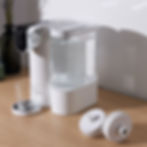PANI SOURCE
Pivoting a stalled out startup
Failure is an opportunity: How we pivoted a stalled startup.
Pani is an Austin based startup, incubated by my product design firm, Kinetic Theory. The first product, a connected water meter that helps people reduce their water usage was showing growth in the B2B space but not performing as desired in the consumer space.
As the founding team was considering wind up options, we suggested we raise another small round of funding in order to explore adjacent markets. After exploring about 10 different potential markets which would include water filters, lifestyle beverages, reverse osmosis systems, and more, we had a eureka moment.
Immediately we began a concepting cycle that lead us to a product that combined a few of these market trends.


Concept Driven by Demand
Our combined quantitative, qualitative, and supplemental research showed us that water quality was a top rated concern across the board, but filtering water was the bare minimum. The team realized that filters was a saturated market but the custom beverage market was in a growth cycle. We combined these trends into a custom countertop beverage concept, in which the user could receive clean filtered water, and then customize it with various vitamin, enhancement, and flavor pods.
Validating the concept
To perform a final validation of the concept, we ran multiple A/B tests on virtual mockup variations of the product concept with customers.
Once it was clear that we had a product concept that was resonating with customers, we then built a non functional physical prototype and produced a commercial and photoshoot as if it were the real product. These assets were then presented in a custom crowdfunding campaign hosted on the Pani website. Using a custom crowdfunding campaign gave the team the ability to start, stop, or modify the campaign as needed, without the need to follow the traditional funding rules of Kickstarter or Indiegogo.

A Successful Raise and The Path Forward
The goal of the crowdfunding was not to actually fund the product, but instead to bolster fundraising efforts. The crowdfunding methodology allowed us to validate our concept product for 1/20 the cost of taking a traditional product fully to market. Investors who would have been hesitant to participate were provided the additional data points needed to feel comfortable in funding the next stage of product development. Ultimately this was a successful effort and Pani is now in the engineering phase of it's lifecycle.












